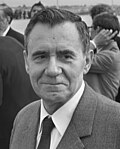Denialism and censorship
Before the deportation of Crimean Tatars in 1944, the term Crimean Tatar was widely allowed to be used in censuses, academic literature, and general use in cultural life. Still, after the deportation, the term was subject to censorship.
The very first sentence of Decree no. 5859ss, the decree ordering the deportation of Crimean Tatars, used the term Crimean Tatar, specifically saying, "many Crimean Tatars betrayed the Motherland." Later government decrees about Crimean Tatars avoided using the term "Crimean Tatar"; Ukaz 493 of 1967, which stated that accusations of universal treason laid against Crimean Tatars were unreasonable, described Crimean Tatars only as "Citizens of Tatar nationality, formerly living in the Crimea." Throughout the era of the Crimean Tatar exile, the Soviet government made many attempts to cover up the existence of Crimean Tatars as a distinct ethnic group to the Soviet public to maintain a fiction that Crimean Tatars were a subgroup of the Volga Tatars.
While Crimean Tatars were able to get away with using their ethnonym in passing mention in limited circumstances, like occasional mentions in the newspaper Lenin Bayrağı , usage of the term "Crimean Tatar" was almost always successfully censored. All token Crimean Tatar cultural activities were treated as manifestations of a subgroup of the Volga Tatars. The Crimean Tatar dance ensemble Haytarma [b] was forbidden from calling itself a Crimean Tatar dance group; Titles of books about Crimean Tatar music and the Crimean Tatar language were never allowed to use the word Crimean Tatar, and instead used vague titles that were non-specific to the subject being Crimean Tatar. Even the Crimean Tatar language department of the Nizami State Literature Institute in Tashkent could not be called a Crimean Tatar language faculty and was named "Tatlit" instead. Only in perestroika were Crimean Tatar academics allowed to use the term "Crimean Tatar" in their dissertations about their language.
Over time, the government went beyond simply censoring the word "Crimean Tatar", and by 1983, Lenin Bayrağı was prohibited from using many words important to Crimean Tatar identity. The restrictions went beyond forbidding the use of Crimean Tatar language names for Crimean toponyms mentioned in articles, but also the term "Crimean ASSR" and even "Crimean Radio Committee." [21]
In the Surgun era, Crimean Tatar musicians were forbidden from performing songs that alluded to or were perceived as alluding to Crimea. The lyrics of the songs were limited to very narrow themes, such as cotton.
Misrepresentations of nationality of Crimean Tatars heroes
Uzeir Abduramanov, a full-blooded Crimean Tatar born and raised in Crimea, [24] was labeled as an Azerbaijani in a photo gallery of Heroes of the Soviet Union in a 1944 issue of the popular magazine Ogonyok. [25] Crimean Tatar national hero and double Hero of the Soviet Union Amet-khan Sultan always personally identified himself as a Crimean Tatar, and was described as a Crimean Tatar in newspaper articles about his heroism that were published before the deportation, [27] but was often described as a Dagestani in post-deportation media, such as in his obituary in the newspaper Dagestan Pravda. [28]
Return of the term
In 1984 the government of the Uzbek SSR began formally allowing use of the term in very limited contexts, such as specifying the language of newspapers and radio programs. Despite this, the government continued to withhold official recognition of Crimean Tatars as a distinct ethnic group. Only in 1989 were Crimean Tatars recognized as a separate ethnic group, and all restrictions on using the term "Crimean Tatar" were lifted. While Crimean Tatars were heavily restricted in using their ethnonym, the government freely used the term in the context of describing accusations of mass treason by Crimean Tatars, like the 1987 TASS statement issued at the start of the Gromyko Commission in perestroika that heavily detailed allegations of collaboration, many false, by Crimean Tatars during World War II.
This page is based on this
Wikipedia article Text is available under the
CC BY-SA 4.0 license; additional terms may apply.
Images, videos and audio are available under their respective licenses.




